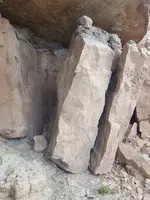I trying to decide what to say. The trail isn't just one direction. It starts in an easterly direction and then heads south and winds back a bit to the west. I believe it is an intersection in the sense that there are multiple directions to head from the basin where the glyphs are. The area is rugged and although traveling overland can be done, there are natural routes that make travel easier. There may have been a time when wagons could have been maneuvered close to the vault area, but not today. Even a very experienced guy on a dirt bike (me) couldn't find a route in to the vault area that wasn't dangerous and not worth it. So basically I think the broader area could easily have been, actually was, a way point for nomadic people or traveling expeditions. One could probably eek out a long term existence there even, but wow what a rough life that would be. Yes, there are sources of water.
With that said, the vault area would have been an area that you went to for other more specific reasons. It is steep, rocky, ledged in, even a bit dangerous. I have seen rocks fall down the 300+ft almost vertical hills and ledges a couple of times. One day I had a softball sized rock almost hit me and my dog when we were walking below a 30ft ledge - it can from above the ledge not off the ledge. If I was a bit more paranoid I would have thought it was thrown at us based on it's trajectory and speed. There is a "spookiness" to the canyon with the vault. Not by the glyphs, but out by the vault area. The more time you spend there the more you feel uneasy. There is kind of a feeling of being watched. I am not trying to be dramatic or anything like that. I think it is a function of being kind of enclosed by steep rocky ledges in a remote area and knowing you are at the mercy of mother nature, but I also like to be out there. The area is mineral rich in some ways, but I have never heard of any large gold deposits there. But I just got a lead an a potential in that regard so I don't know. Of course gold is often found in the strangest places anyway. And quartz and iron, yes they are there. Some silver and copper too.
Check out this large boulder overlooking the vault area. It is strange and probably contributes to the feeling of being watched. I call it skull rock. haha. It sits about 40ft above on a ledge and "looks" back down at the turtle and hearts.




